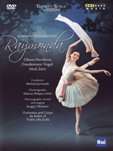|
Back
05/24/2012
Aleksandr Glazunov: Raymonda, opus 57 (Choreography by Sergej Vikharev after Marius Petipa)
Olesia Novikova (Raymonda), Friedemann Vogel (Jean de Brienne), Mick Zeni (Abderahman), Mariafrancesca Garritano (Henriette), Francesca Podini (Clémence), Claudio Coviello (Béranger), Marco Agostino (Bernard de Ventodour), Sabina Galasso (Countess Sybille), Luigi Saruggia (Andrew II), Manuela Aufieri (The White Lady), Matteo Buongiorno (Seneschal), Matthew Endicott (Officer Verlé), Antonella Albano/Daniela Cavalleri (Soloists, Act I, Scene II), Serena Sarnataro/Maurizio Licitra (Saracen Dance, Act II), Beatrice Carbone/Eris Nezha (Spanish Dance-Panadéros), Lara Montanaro/Alessandro Grillo (Mazurka, Act III), Emanuela Montanari/Mick Zeni (Palotás, Act III), Antonella Albano (Soloist, Pas classique hongrois), Orchestra and Corps de Ballet of Teatro alla Scala, Makhar Vaziev (Ballet Director), Accademia Teatro all Scala Ballet School, Frédéric Olivieri (Ballet Director), Mikhail Jurowski (Conductor), Lorena Sardi (TV and Video Director), Sergej Vikharev (Stage Director), Orest Allegri/Pëtr Lambin/Konstantin Ivanov (Original Set Designers), Elena Kinkulskaya/Boris Kaminsky (Recreated Set Designers), Ivan Vsevoložskij (Original Costume Designer), Irene Monti (Recreated Costume Designer), Marco Filibeck (Lighting Designer)
A production of Rai Tre and Rai Trade
Recorded live at the Teatro alla Scala (October 11, 2011) – 154’
Arthaus Musik Ref #: NTSC 101 630 – Booklet in English, French and German. Subtitles in Italian

   
Since 1999, former Mariinsky Theatre soloist Sergej Vikharev has focused on reconstructing some of Russia’s most beloved ballets, upholding a distinguished level of integrity to his art form. Drawing upon notes (via Harvard University) of Nikolai Sergeyev, former Mariinsky Theatre imperial dancer, Vikharev subsequently teamed up with Milan Ballet Director Makhar Vaziev to respectfully extrapolate Marius Petipa’s original vision. This decoding of Raymonda, two years in the making, has resulted in one of the most enthralling and historical productions.
By the end of the 19th century audiences were captivated by anything involving exotica, fairytales or chivalry. Though the plot of Raymonda is feeble, it serves great purpose to showcase Petipa’s artistic movements while supported by the opulent score of Alexandr Glazunov. Glazunov’s music can be seen as a bridge between Eastern and Western Europe: a calico patchwork of thematic rhythms reaching beyond his Motherland but never straying far from Russian underpinnings with hints of Rimsky-Korsakov, Tchaikovsky and flits of Ippolitov-Ivanov. Raymonda, a veritable sketchbook of colorful dance numbers requiring a huge corps de ballet, allows dancers on all levels to bask in the glory of spotlights if but for only a few brief minutes.
A ballet in three acts, the curtain rises on Kinkulskava’s and Kaminsky’s rich backdrop that is enhanced by the wonderful medieval costuming by Irene Monti. The setting is so beautifully constructed that it could be mistaken for a Vermeer painting.
Olesia Novikova is a perfect and confident Raymonda, exhibiting well expressed nuances and soufflé lightness. It is also one of the most challenging roles. Whether it be a solo or the Pas classique hongrois, she possesses remarkable fluidity and clean lines. Most of Friedemann Vogel’s dancing comes to life in Act III where he executes beautifully precise grands jetés in his “Variation de Jean de Brienne.” Raymonda’s friends Henriette and Clémence, performed by Mariafrancesca Garritano and Francesca Podini, respectively, add charm and graceful support to Novikova in many of the ballet’s passages. Mick Zeni’s penetrating eyes woo Raymonda in Act II with great intensity while the gesticulations of Galasso’s Sybille and Aifieri’s The White Lady add pleasing continuity.
Olivieri’s youthful troupe is well focused, sharp and filled with smiling faces during the “Rapsodie – Danse des enfants” which is soon followed by the zesty “Palotás”, a traditional Hungarian dance. The Grand divertissement is an anthropological pastiche of catchy steps from all corners of the world, and in the middle we find the “Panadéros” featuring the punctuated pairing of Beatrice Carbone and Eris Nezha set to the sounds of snappy castanets. Despite its shortness, the “Panadéros” is still an inevitable crowd pleaser.
Raymonda is well recorded utilizing many different camera angles, and the sound quality is impeccable. For a company that spent countless hours of research and preparation, it is disappointing to see one grossly overlooked element: detail. Michail Jurowski’s Orchestra is absolutely splendid, but never does the curtain fall precisely at the close of the music in each act. Several times music does not end sharply with a solo dancer’s final snap in position. Wherever responsibility rests, it is unfortunately sloppy and irksome. Nonetheless, this reconstruct that pays homage to Petipa and Glazunov is a remarkable achievement, and it is highly recommended. Raymonda is a ravishing delight from beginning to end.
Christie Grimstad
|